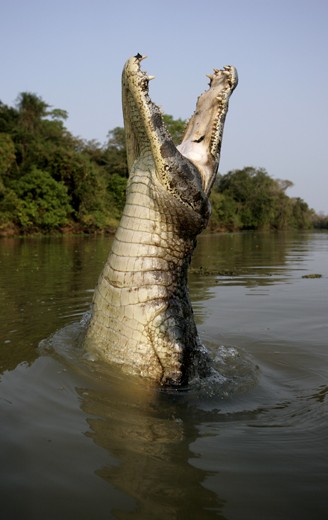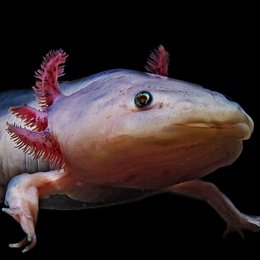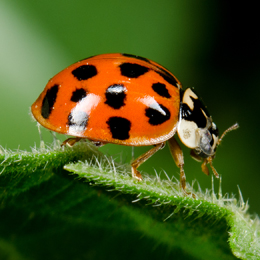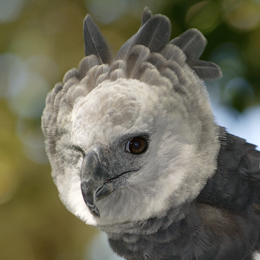Physical Appearance
Spectacled caimans are small to medium sized crocodilians that attain an average size of 1.8 – 2 m (5.9 – 6.6 ft) in case of male caimans while females measure 1.2 – 1.4 m (3.9 – 4.6 ft). According to the latest survey, the largest spectacled caiman attained a length of 2.5 m (8.2 ft) and weighed 58 kg (128 lbs). The species is a voracious feeder that generally weighs between 7 – 40 kg (15 – 88 lbs) and can live for around 30 – 40 years in the wild.
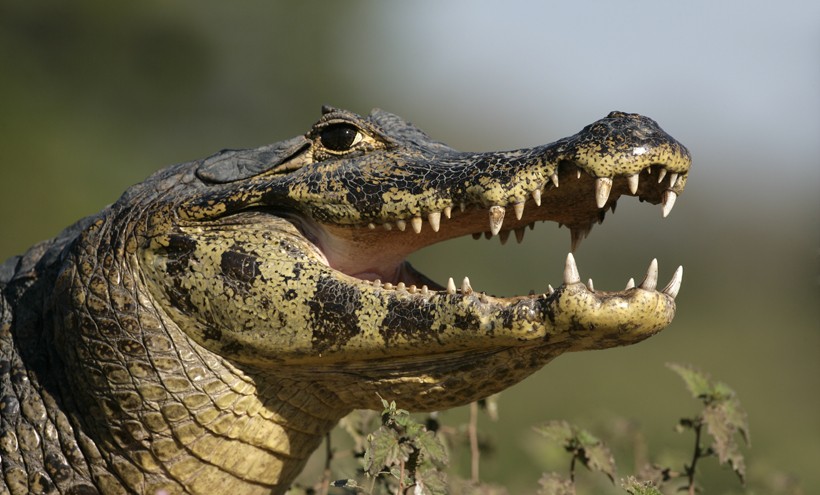
Closeup head Spectacled Caiman
?
Image credits: Erni/Shutterstock
The spectacled caiman obtained its name because of the presence of a bony ridge that lies between its eyes giving the appearance of a pair of spectacles. The spectacled caiman has been divided into four subspecies: C.c.crocodilus, C.c.fuscus, C.c.chiapascius and C.c.apaporiensis. All are acknowledged as separate subspecies based on their location, distribution and certain physiological adaptations. C.c.yacare was initially considered the fifth subspecies but has been acknowledged a separate species entirely and is commonly referred to as ‘Yacare Caiman’.
Geological Distribution of Subspecies
The geographic range of the spectacled caiman ranges from Central America to northern parts of South America and can also be found in certain parts of the Caribbean. The Spectacled caiman can tolerate salt as well as freshwater, therefore, it is the most common of all crocodilian species. The extensive Pantanal floodplain provides a perfect habitat for the caiman during the rainy season. They have recently been introduced in Cuba, Brazil, Puerto Rico and Columbia. The species is native to many tropical countries like Ecuador, Mexico, Guyana, Guatemala, Honduras, Costa Rica, El Salvador, Panama, Peru, Suriname, Trinidad, Tobago and Venezuela. The subspecies distribution is based on their geographical range:
- C. c. crocodilus: Found in Llanos in Venezuela, Orinoco and Amazon drainage system, east of Bolivia, Peru, Guyana, Ecuador and northern Brazil
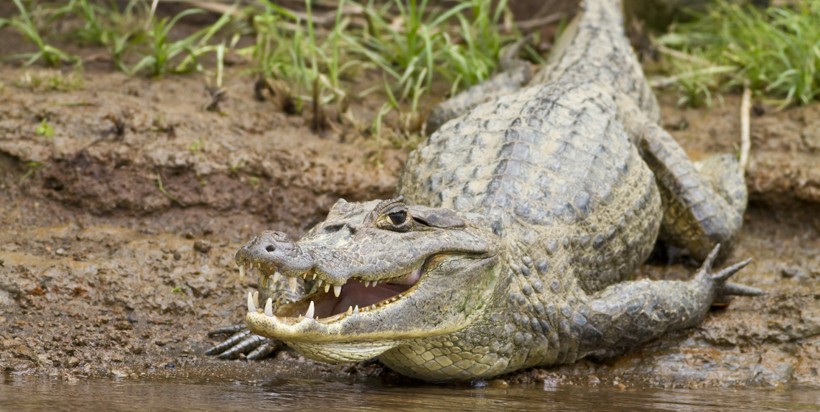
Caiman crocodilus fuscus
?
Image credits: Chris Pole/Shutterstock
- C. c. fuscus: Found in the Atlantic coastal drainage of Colombia, Magdalena River, Nicaragua, western Venezuela and Ecuador
- C. c. chiapascius: Found in Pacific coastal Oaxaca and Chiapas in Mexico, El Salvador and Gulf of Uruba
- C. c. apaporiensis: Found in upper Apaporis River of Colombia and Venezuelan Llanos
Habitat
The Spectacled caiman can be found in a variety of habitats ranging from freshwater to saltwater ecosystems. It is a very adaptable species that can withstand a wide range of salinities and therefore can also be found along estuaries, lakes and brackish water. The species prefers rivers and wetlands where usually slow moving water persists. They occupy coastal environments that majorly contain estuarine lagoons and small patches of river mouths.
A typical habitat of the spectacled caiman will include several vegetative components like mangrove communities, mixed rainforests, sand backshores, sea grasses and wooded swamps. The species resides in humid tropical lowlands where there is high rainfall. The spectacled caiman prefers to swim or bask on soft sandbanks during the day that are located near riverbeds, marshes, ponds and lakes.
Anatomy
The Spectacled caiman gets its name from the bony ridge that exists along the front of its eyes giving an appearance that is similar to wearing a pair of spectacles.
The species is a small to medium sized crocodile that has a relatively broad and blunt snout. In addition to the bony ridge, the caiman also possesses a triangular ridge on the top of its eye. Certain physical differences can be observed in the subspecies like the C. c. apaporiensis which displays a more narrow-snouted form. It maintains a typical dark gray-green coloration although the species changes color depending on the climate. During the winter season, the black pigment that is found within their skin cells expands giving the species a darker coloration.
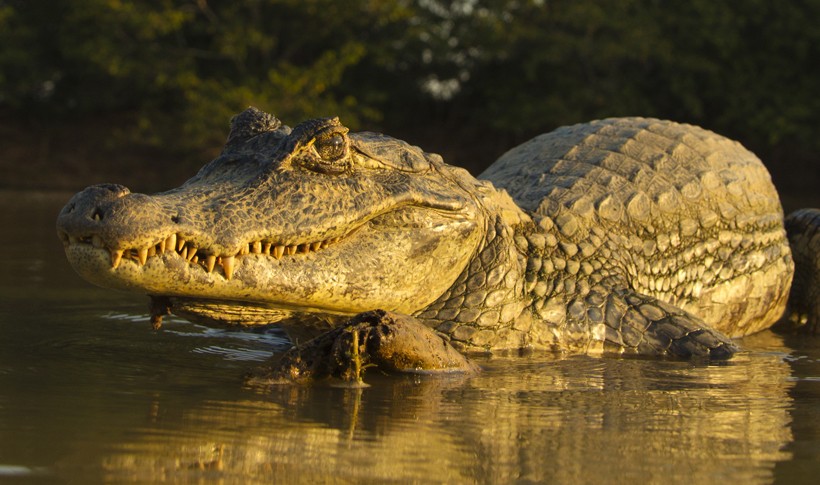
The skin-color darkens during the winter season.
?
Image credits: Joe McDonald/Shutterstock
There is sexual dimorphism in the species where female spectacled caimans are smaller as compared to the male counterparts. Average adults generally maintain an olive to a nearly black appearance with variable yellow or black crossbands spread throughout the body. They have long snouts, a bony infra-orbital bridge between the eyes and a fourth mandibular tooth that isn’t visible from the outside. The species showcases bilateral symmetry and, like all reptiles, is an ectothermic being which means it regulates its body temperature using external heat sources. Juvenile spectacled caimans generally reserve a lighter coloration that can be yellowish to olive green with dark bands or spots. They usually measure 0.5 – 1 m and stay beside their parents till they reach a minimum adult length of 1.2 – 1.4 m.
Diet and Feeding Habits
The spectacled caiman eats a variety of invertebrates that mostly consist of fish, crustaceans, insects, snails, shrimps, snakes, lizards and turtles. Adult spectacled caiman feeds on fish and water snails while really old specimens can easily take down larger mammalian prey like wild pigs. The nominate subspecies of the spectacled caiman (C. c. crocodilus), located within the Amazon drainage system, primarily feeds on piranhas and therefore ecologically important. As they age, the variety of invertebrates like amphibians, rodents reptiles and water birds as their food source increases. Cannibalism has been reported, but only during severe drought conditions when there is a scarcity of prey.
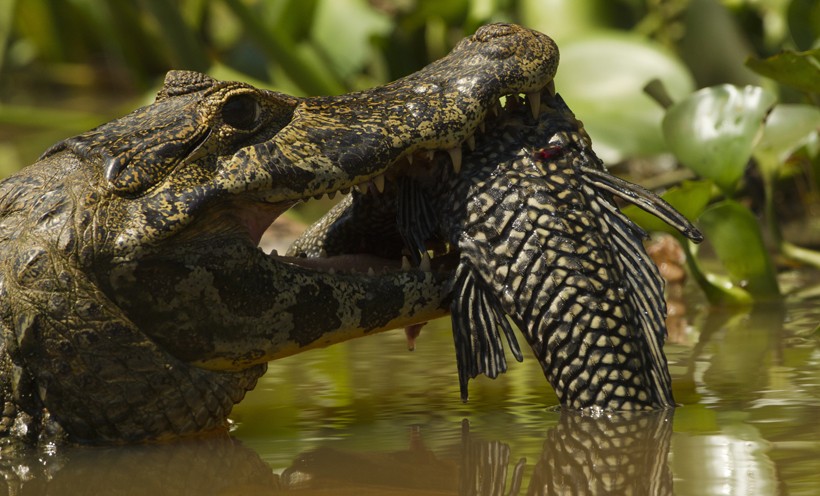
Spectacled Caiman catching a fish, Brazil
?
Image credits: Joe McDonald/Shutterstock
Spectacled caimans are nocturnal hunters and usually rely on ambushing their prey. They feed on a variety of invertebrates being majorly fish, mollusks, crustaceans, reptiles and small mammals. Juvenile spectacled caimans learn to fend for themselves at an early age and they primarily feeding on fish eggs, tadpoles, insects and baby turtles. The aquatic predator hunts in water as well as on terrestrial grounds. Feeding activity primarily takes place during the wet season when prey is abundant. The caiman uses its heavily armored body to weigh down its prey after ambushing it from a hidden location. Whether it is under water or camouflaged within a muddy swamp, the caiman is agile and swift in catching its prey. It uses its body to lure fish towards the surface and traps it against the shore. If environmental conditions become harsh, the species may burrow mud holes and aestivate.
Predation
Though the spectacled caiman is an aggressive predator it is often hunted upon by larger animals. Juvenile caimans often fall prey to predatory birds, large snakes and foxes. During nesting time Tegu lizards are known to destroy their nests and consume the eggs. Other predators that attack spectacled caimans are herons, anacondas, coatis and humans.
Reproduction
The spectacled caiman reaches sexual maturity between 4 – 7 years although the more dominant individuals can reach maturity earlier. It is only during the mating season that the caiman showcases a territorial habit and social behavior. The mating season takes place between the months of April and August, which is the wet season. Mating is polygynandrous with both males and females copulate with multiple partners. Courtship behavior is often observed during the breeding season where prospective mates can be seen swimming together, foraging, bellowing, touching snouts, rubbing backs and circling around one another. Once a female chooses its mate, she will build a nest in the male’s territory. Social status affects growth rate and reproduction because smaller caimans often cannot mate due to social stress from larger, more dominant male caimans.
Once copulation takes place, the female caiman usually lays eggs from July to November although this is dependent on the climatic conditions. The female is oviparous and lays an average clutch size of 20 – 40 eggs. The incubation period is between 65 – 104 days. The newborns' gender is determined by the temperature of the nest. Before nesting, the female spectacled caiman uses rubble, mud, vegetative scrub and leaf cover to create a mound that is guarded by both parents once the eggs are laid. The decomposing vegetation helps to regulate the temperature of the nest. After hatching, there is parental care by both parents who excavate their young ones out the egg shells. The young hatchlings stay under parental care for around 1.5 years.
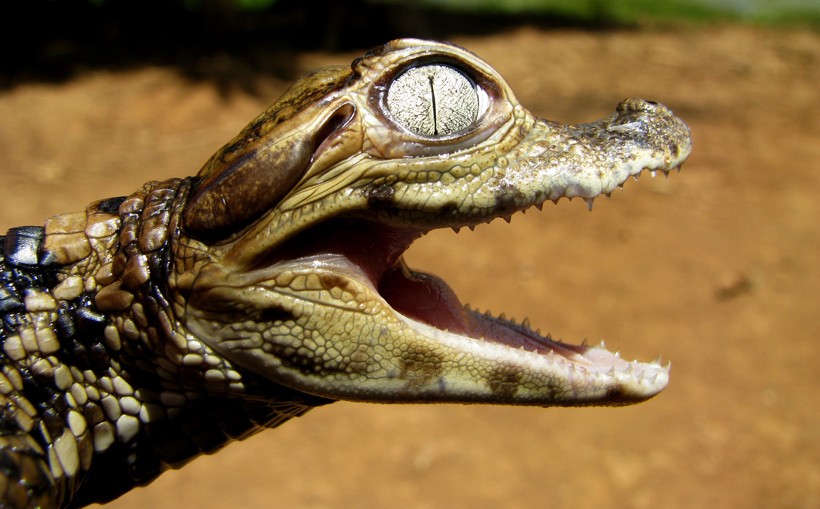
Newborn spectacled caiman hatchling
?
Image credits: Fabio Maffei/Shutterstock
During incubation, the female spectacled caiman showcases a protective maternal behavior and usually feed scraps to the newborn for a few months till they have learned to hunt. Spectacled caimans become quite territorial during this phase and usually restrict their young ones from hunting in foraging grounds that lie outside their territory. Both parents take responsible roles of protecting the hatchlings from predation. The juvenile caimans gain independence upon attaining a minimum length of 0.5 – 1 m. Young hatchlings reserve a yellow coloration with dark black spots. Although the juvenile caimans stay near their mother initially, they hunt their own food.
Behavior
The spectacled caiman is found in South and Central America including the Amazon basin. They can be found in tropical lowlands, seasonally flooded savannahs, rivers, swamps and rainforests. This crocodilian species frequently swims around the surface of the water body or bask near wooden logs to increase their body temperature. The species is quite cautious as it observes movement in and around itself while submerged in water. The spectacled caiman is an intelligent species that primarily hunts at night. The species is an apt swimmer because of its webbed feet and uses its tail to propel itself through the water. The coloration of the species is murky green or dull olive green with dark cross bands allowing it to easily camouflage in the wild. They have 75 long, sharp and conical teeth that are used for catching prey. They generally remain within their home range since the species is territorial and showcases social hierarchy.
Spectacled caimans are generally shy solitary creatures except during the mating season when they become aggressive and territorial. They can often be found in small scattered groups but don’t show many group traits. There is a presence of social hierarchy within the species where social ranking is determined by size, strength and dominance. Animals with a higher rank generally have a larger prospect of mating multiple times during the breeding season. They show little movement in the morning and prefer staying submerged. While foraging caimans become exceptionally territorial and can usually be seen patrolling forest patch and water sources that are familiar. The muscles along the jaw are capable of generating enormous power which can crush turtle shells and latch onto a large prey easily. While adults consume fish, amphibians and mammals, juveniles forage invertebrates like tadpoles, snails and crabs.
The spectacled caiman has specific sensory organs on its skin to detect (changes in) heat, touch and chemicals in the environment. These micro-organs are known as integumentary sensory organs spread on the cranial and postcranial scales. These micro-organs can detect chemical stimuli and physical parameters like surface pressure waves in the water, indicating movement. The impermeable multi-layered epidermis and skin appendages that are composed of keratin provides mechanical, thermal and chemical protection. Special sensory organs in the snout give the caiman a heightened sense of smell allowing it to detect prey that is approximately 10 – 15 feet away.
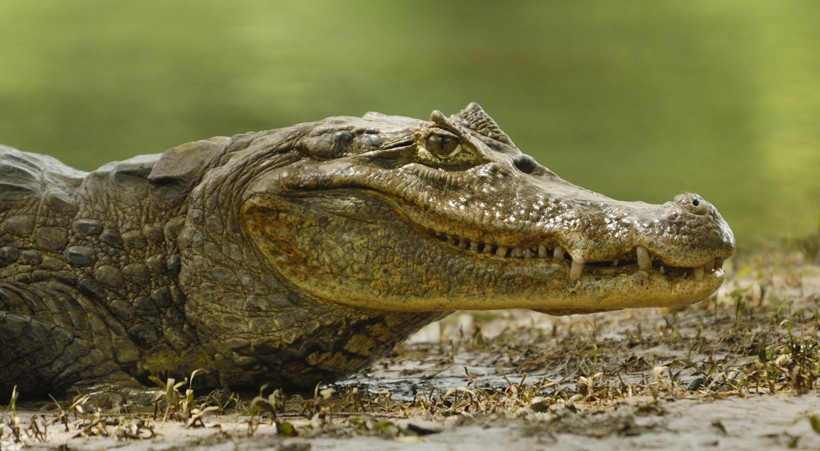
Spectacled Caiman Basking
?
Image credits: Hugh Lansdown/Shutterstock
The eyes of the spectacled caiman are protected by a transparent eyelid that moves sideways across the eye when the species submerges or even attacks prey. To pinpoint the orientation of a prey, the caiman also possesses highly developed inner and middle ears and a protected auditory canal by ear drums on either side.
Communication
The spectacled caiman uses a variety of gestures to communicate with its mate during courtship and post-natal care. They are quite vocal in general and use a variety of techniques for communication like distress calls emitted by juveniles, threat calls that a female emits to a young one, hatchling calls and courtship bellows by male caimans during the breeding season. Bellowing is performed by inhaling air into the lungs and releasing it intermittently in the form of deep-toned roars to attract mates and warn intruding males. Spectacled caimans vibrate their bodies under water to produce ripples that travel long distances. This is known as the ‘water dance’ of the caimans which is performed to attract a potential mate. Other bodily movements can be thrashing of the tail, slapping of the heads and rubbing of the body against a potential mate.
Threats
Although Costa Rica, Brazil and Mexico showcase stable populations of the spectacled caiman, there are certain areas where the population has decreased massively. According to a recent survey of the subspecies C. c. fuscus in the Cispata Bay and Via Parque Isla de Salamanca, there has been a subsequent decline in the adult population of this spectacled caiman. The spectacled caiman faces a few threats from human invasion because of which their population has suffered a recent decline. The skin of the spectacled caiman is commercially less valuable but it is mostly hunted for its meat and eggs. Because many other crocodilian species have been reduced in number over the last few years, the spectacled caiman has become a common target for poachers and illegal tradesmen. Apart from being collected for pet trade, the spectacled caiman faces massive habitat loss due to illegal mining and deforestation. Most under threat is the subspecies C. c. apaporiensis which has a highly restricted range in Colombia and is already depleted in El Salvador. Because it is being introduced to new habitats, research specifies that the spectacled caiman has become a major threat and competition for other crocodilian species like the Cuban crocodile in the Isle of Pines, Cuba.
Conservation
On a global scale, the population of the spectacled caiman is already on a decline, especially in countries like Peru, El Salvador and Colombia. Smuggling rings that operate from Thailand and Singapore are responsible for illegal hunting of the species. Currently, according to the IUCN Red List, the species is listed as Least Concern and has been mentioned in the CITES Appendix II. High priorities for the conservation of the spectacled caiman include captive breeding programs, intensive research, long-term ecological studies, monitoring of harvest levels and trade controls under the laws that govern CITES listings. Man-made water bodies such as cattle ranches introduced in Venezuela have benefitted the species greatly. In 2004 a captive breeding program was introduced by fishing communities for conserving the natural gene pool of the spectacled caiman in Canal del Dique which was a huge success. In Venezuela, a cropping program which allows controlled hunting has ensured the stability of the caiman population using a rigorous system of licensing producers, hunters and processors.
Funfacts
- The Spectacled caiman showcases a ‘minimum posture’ under water where only the eyes, ears, nostrils and the cranial platform are in view.
- Spectacled caimans possess a second route for breathing which is through the mouth during which the palatal valve is open.
- Spectacled caimans have poor vision under water. However, their eyes are mostly focused for aerial viewing.
- Spectacled caimans use ‘eyeshine’ to detect their prey at night, which is the reflection of an object located quite far away.
- Spectacled caimans are able to change the color of their skin and become dark colored during the cold season.
- Spectacled caimans have 14 – 16 pairs of teeth in the upper jaw and 18 – 20 pairs in the lower jaw.
- The illuminated eyes of the spectacled caiman reflect red during the night making it easy to spot them.
- Spectacled caimans produce bubbles and circulate around a potential mate when they are ready to copulate.
- According to the US Federal List the spectacled caiman is a threatened species.
